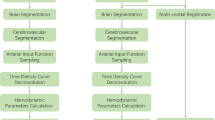Abstract
The purpose of the study was to determine the ability to predict infarct age based on decrease in apparent diffusion coefficient (ADC) values. We retrospectively identified 94 individuals (age range 16 years to 91 years; mean 63.7 + 14.1 years) who underwent magnetic resonance diffusion-weighted imaging at our institution over a course of 14 months whose infarct age could be reliably determined within 1 h. A single observer measured ADC values within the center of the infarct and compared them against values in contralateral normal tissue. We examined the ability of four ADC decrease thresholds (i.e., >50%, >40%, >30%, and >20%) to predict infarct age of <24 and <48 h. Levels of ADC decrease in infarcts were as follows: <20%, n = 9; 20–29%, n = 21; 30–39%, n = 25; 40–49%, n = 23; >50%, n = 16. For prediction of infarct age <24 h, sensitivity for the four ADC decrease thresholds ranged from 25% to 94%, specificity ranged from 10% to 85%, positive predictive value (PPV) ranged from 18% to 25%, and negative predictive value (NPV) ranged from 85% to 89%. For prediction of infarct age <48 h, sensitivity ranged from 23% to 98%, specificity ranged from 15% to 87%, PPV ranged from 46% to 56%, and NPV ranged from 60% to 89%. Test performance characteristics for predicting infarct age of <24 and <48 h were relatively poor. In particular, PPV was very low for predicting infarcts <24 h old.


Similar content being viewed by others
References
Vermeer SE, Longstreth WT Jr, Koudstaal PJ (2007) Silent brain infarcts: a systematic review. Lancet Neurol 6:611–619
Manfredini R, Boari B, Smolensky MH et al (2005) Circadian variation in stroke onset: identical temporal pattern in ischemic and hemorrhagic events. Chronobiol Int 22:417–453
Limburg M, Wijdicks EF, Li H (1998) Ischemic stroke after surgical procedures: clinical features, neuroimaging, and risk factors. Neurology 50:895–901
Pierpaoli C, Righini A, Linfante I et al (1993) Histopathologic correlation of abnormal water diffusion in cerebral ischemia: diffusion weighted MR imaging and light and electron microscopic study. Radiology 189:439–448
Huang I-J, Chen C-Y, Chung H-W et al (2001) Time course of cerebral infarction in the middle cerebral arterial territory: deep watershed versus territorial subtypes on diffusion-weighted MR images. Radiology 221:35–42
Eastwood JD, Engelter ST, MacFall JF, Delong DM, Provenzale JM (2003) Quantitative assessment of time-course of infarct signal intensity on diffusion weighted Images. AJNR 24:680–687
Kidwell CS, Saver JL, Mattiello J et al (2000) Thrombolytic reversal of acute human cerebral ischemic injury shown by diffusion/perfusion magnetic resonance imaging. Ann Neurol 47:462–469
Oppenheim C, Grandin C, Samson Y et al (2001) Is there an apparent diffusion coefficient threshold in predicting tissue viability in hyperacute stroke? Stroke 32:2486–2491
Ahlhelm F, Schneider G, Backens M, Reith W, Hagen T (2002) Time course of the apparent diffusion coefficient after cerebral infarction. Eur Radiol 12:2322–2329
Copen WA, Schwamm LH, Gonzalez RG et al (2001) Ischemic stroke: effects of etiology and patient age on the time course of the core apparent diffusion coefficient. Radiology 221:27–34
Fiebach JB, Jansen O, Schellinger PD, Heiland S, Hacke W, Sartor K (2002) Serial analysis of the apparent diffusion coefficient time course in human stroke. Neuroradiology 44:294–298
Back T, Hirsch JG, Szabo K, Gass A (2000) Failure to demonstrate peri-infarct depolarizations by repetitive MR diffusion imaging in acute human stroke. Stroke 31:2901–2906
Author information
Authors and Affiliations
Corresponding author
Rights and permissions
About this article
Cite this article
Provenzale, J.M., Stinnett, S.S. & Engelter, S.T. Use of decrease in apparent diffusion coefficient values to predict infarct age. Emerg Radiol 17, 391–395 (2010). https://doi.org/10.1007/s10140-010-0869-8
Received:
Accepted:
Published:
Issue Date:
DOI: https://doi.org/10.1007/s10140-010-0869-8




